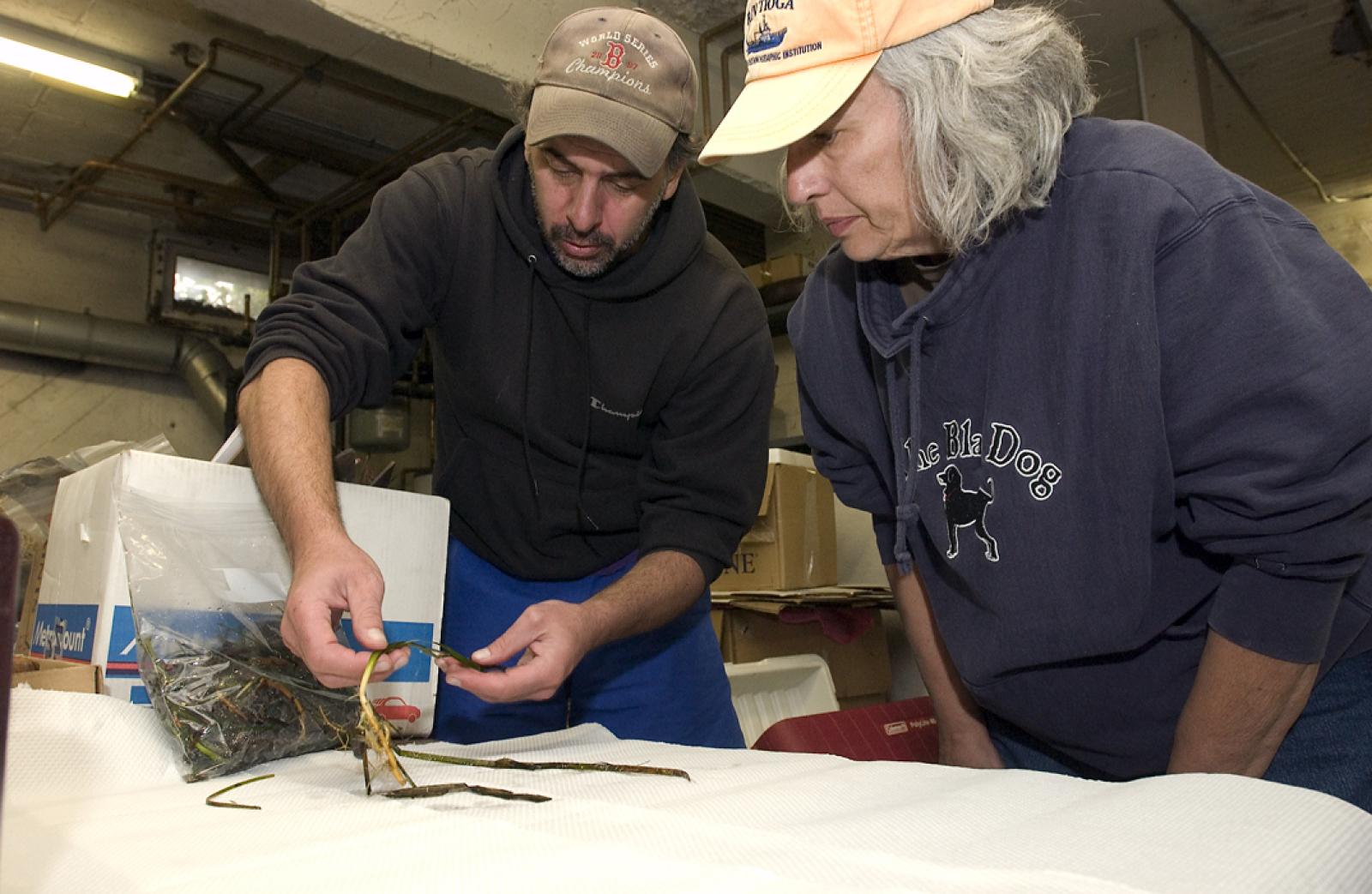It sounds like a bad science fiction movie: a slime from outer space has reached the earth. It spreads underwater across the harbors and bays of a small Island community and eventually throughout the East Coast. The world’s top scientists gather to study and discuss the problem..
What it sounds like is nearly true in the waters along the eastern seaboard, only in this case the slime is believed to come from the Sea of Japan.
For three days this week, a group of half a dozen scientists gathered on the shores and in the ponds of the Vineyard, searching for tunicates. Divers from the Environmental Protection Agency’s Boston and Narragansett offices and a U.S. Geological Survey underwater image specialist came to lend a hand to a top biologist and expert on tunicates from the Woods Hole Oceanographic Institution.
They found plenty of what they were looking for. Slippery, slimy tunicates are indeed invasive foreign creatures that grow quickly in the waters off New England. They are the ocean equivalent of bittersweet and Russian olive.
The scientists who visited the Vineyard this week were specifically looking for the presence of tunicates on fragile eelgrass blades.
Dan Blackwood, the marine visual images specialist out of Woods Hole, photographed the ocean bottom for the first time on Georges Bank in 2002. He said they found acres of tunicates covering the ocean floor.
The question confronting marine scientists and local shellfish constables, who helped in the survey, is what the tunicates will do to eelgrass beds.
Mary Carman works at the Woods Hole Oceanographic Institution and has been assigned to learn all she can about the tunicates; she has worked for 10 years as a research associate with the biology department.
She believes the tunicates came from the Sea of Japan more than 20 years ago via the cultured oyster fishery. The animals traveled either on the oysters or on the seaweed that they were packed in. Her first memory of seeing tunicates on the eastern seaboard goes back a decade. She said she found them growing in a tidal pool in Sandwich at the entrance to the Cape Cod Canal. Now tunicates are being found on spiles and mooring lines, in fixed fishing gear, the bottom of boats and beyond. “It grows like a weed and spreads and adapts. Martha’s Vineyard is a good representation of what is happening across New England,” Ms. Carman said. Beyond the Vineyard she is sampling on Cape Cod, Woods Hole and on each end of the Panama Canal.
She described the expansion of the plant, which has few predators, as “alarming.”
The problem has drawn the attention of the EPA and U.S. Geological Survey as well as WHOI. In 2001, Ms. Carman hosted an ocean invasive species workshop in Woods Hole that primarily focused on the expanding tunicate invasion. She said 14 people attended.
In 2005 she hosted another workshop and 120 people attended representing 10 countries. If another workshop were held today, she believes the number would be even larger.
The divers worked on the Vineyard from Monday through Wednesday. They found tunicates in every pond they searched. “Last fall we found them only on eelgrass in Lake Tashmoo and in Major’s Cove in Sengekontacket Pond,” Ms. Carman said. “It spreads pretty quickly.”
This time they found tunicates growing in Katama Bay, Sengekontacket, Lagoon and Menemsha Ponds.
“Unexpectedly we found large solitary tunicates, [Ascidiella aspersa] the size of a thumb, in Menemsha Pond. It could be occurring elsewhere, we just didn’t see it,” she said.
They found Didemnum vexillum, which was found in large areas of Georges Bank, once the nation’s most productive fishing ground.
But the primary focus of this trip was to examine how tunicates grow on eelgrass, an essential plant in the health of coastal ponds. Among other things eelgrass is essential to a healthy bay scallop population.
Phil Colarusso, an EPA marine biologist who has studied eelgrass in New England for years and on the Vineyard since 1995, said he has seeneel grass beds make a comeback when towns improve the water quality of their harbors. He said to the delight of many, eelgrass beds are making a comeback in Boston Harbor, New Bedford and Gloucester, all because of the care given to cleaning up local waters. He and Bill Wilcox, water quality planner with the Martha’s Vineyard Commission, have also seen eelgrass beds on the Vineyard make a comeback.
But they said the arrival of tunicates opens new challenges.
“It is conceivable that when the tunicate coats the surface of a plant it does harm. With eelgrass, I don’t know if we are looking at the leading edge of something bad. Will these animals cover a large per cent of the eelgrass beds?” Mr. Wilcox asked.
He said scientists are studying whether the eelgrass plant can rid itself of tunicates when it sheds its leaves at the end of each year. “I don’t know what to expect. But having these people here, who know eelgrass and know tunicates will feed into our understanding of the problem,” Mr. Wilcox said.
Ms. Carman said marine scientists have learned much about tunicates. They know that they don’t grow well on sand and mud and like to adhere to stone. They also like eelgrass. But scientists discovered this week that tunicates will only grow up to 25 per cent of the length of a blade of grass. Ms. Carman said scientists don’t know whether this means the eelgrass will live despite the tunicate, or whether the plant roots will ultimately be buried in slime.
She said some research is being done to discover a possible medical use for tunicates.
David Grunden, Oak Bluffs shellfish constable, and Paul Bagnall, Edgartown shellfish constable, assisted the research team by providing boats and advice about the best places for sampling.
Mr. Grunden said he hopes to see more of this kind of work in the future. He said it can only help the Island.








Comments
Comment policy »